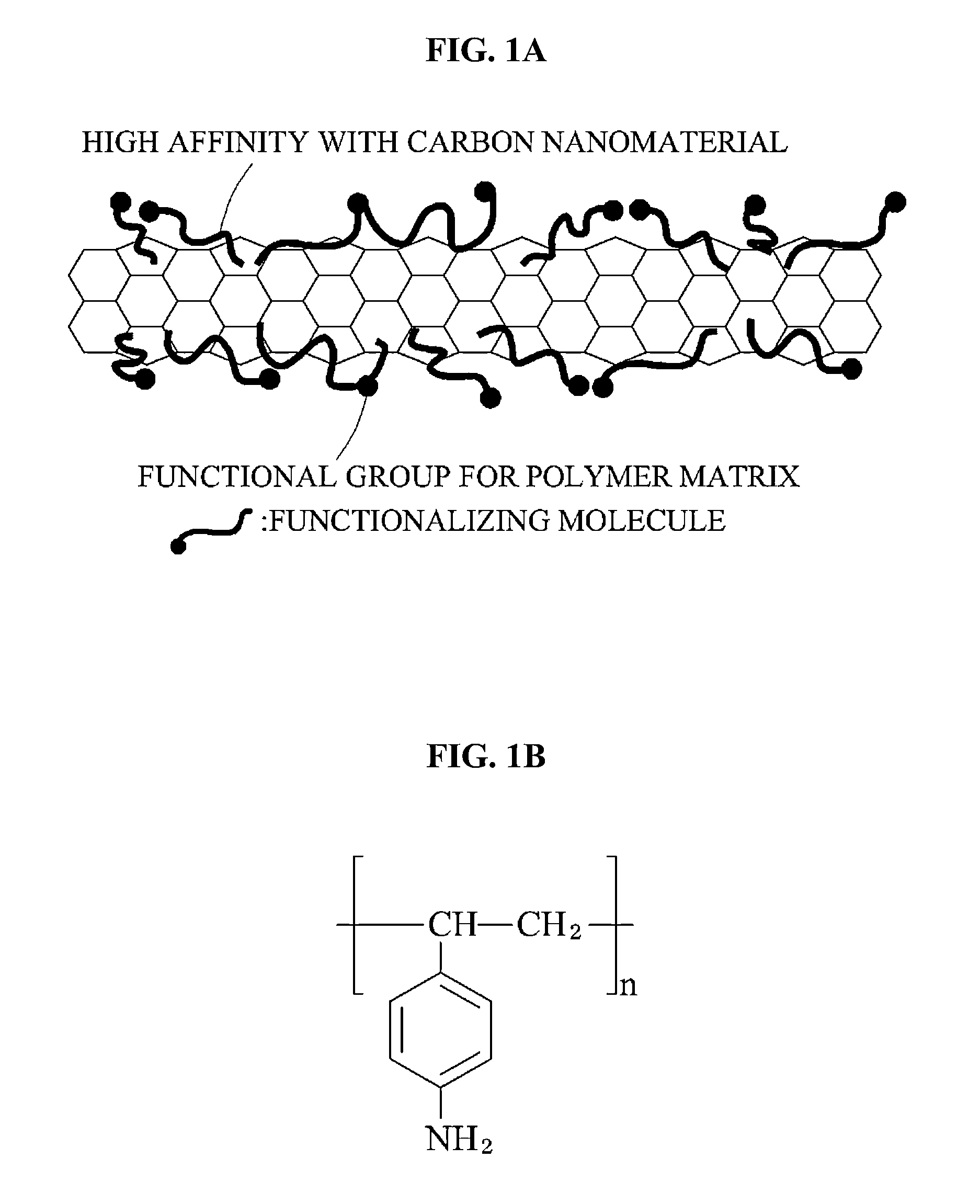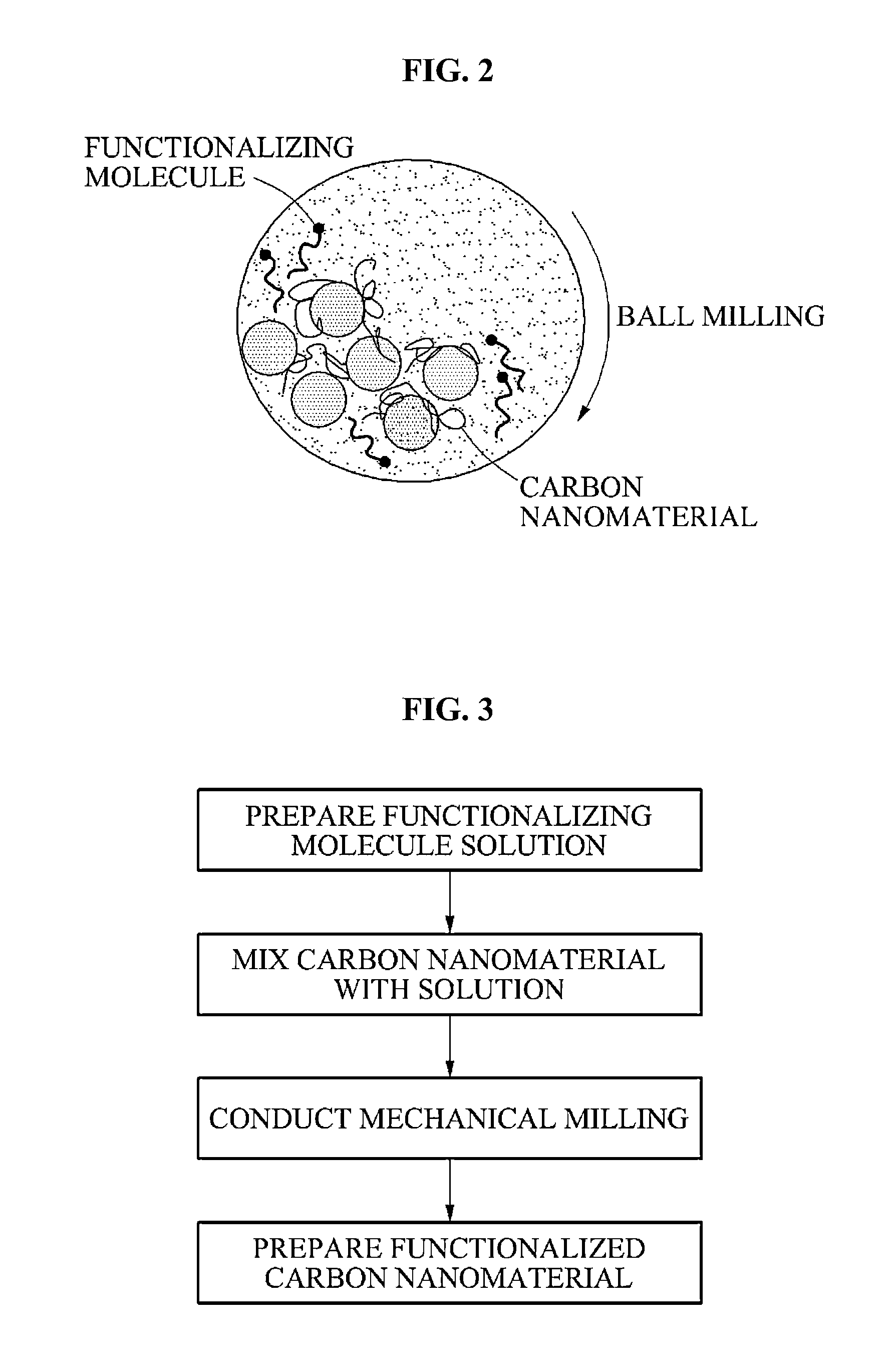Carbon nanomaterial, carbon nanomaterial-polymer composite material, carbon fiber-carbon nanomaterial-polymer composite material, and methods of preparing the same
a carbon nanomaterial and composite material technology, applied in the field of carbon nanomaterials carbon nanomaterialspolymer composite materials, can solve the problems of carbon nanomaterials easily forming agglomerates in a matrix, carbon nanomaterials do not properly exhibit their own physical properties, and reduce physical properties
- Summary
- Abstract
- Description
- Claims
- Application Information
AI Technical Summary
Benefits of technology
Problems solved by technology
Method used
Image
Examples
example 1
Preparation of Functionalized Carbon Nanomaterial (PAS-CNT)
[0113]Poly-4-aminostyrene (PAS, Polysciences, USA, 300 mg, room temperature) was dissolved in N,N-dimethylforamide as a solvent to prepare a PAS solution as a functional molecule solution, which is mixed with a CNT (Hanwha Chemical, Korea, 700 mg), thereby preparing a mixture solution. The mixture solution was subjected to ball milling (200 rpm, 24 hours), filtered for 30 minutes, and dried at room temperature in a vacuum, thereby producing PAS-CNT powder.
example 2
Preparation of Functionalized Carbon Nanomaterial (PAS-CNT)
[0114]Polystyrene sulfonate (PSS, Sigma Aldrich, USA, 300 mg, room temperature) was dissolved in N,N-dimethylforamide as a solvent to prepare a PSS solution as a functional molecule solution, which is mixed with a CNT (Hanwha Chemical, Korea, 700 mg), thereby preparing a mixture solution. The mixture solution was subjected to ball milling (200 rpm, 24 hours), filtered for 30 minutes, and dried at room temperature in a vacuum, thereby producing PSS-CNT powder.
[0115]FIG. 6 is a graph illustrating Fourier transform-infrared spectroscopy (FT-IR) results of an unfunctionalized CNT (pure CNT), a CNT functionalized through strong acid treatment (acid treated CNT), the PAS-CNT prepared in Example 1 and the PSS-CNT prepared in Example 2. As shown in FIG. 6, the strong acid treated CNT exhibits a characteristic peak by a C═O group formed by oxidation as compared with the unfunctionalized CNT, the PAS-CNT exhibits a characteristic peak...
example 3
Preparation of Carbon Nanomaterial-Polymer Composite Material (PAS-CNT-Epoxy Composite Material)
[0117]The PAS-CNT prepared in Example 1 and an epoxy resin (KFR-120, Kukdo Chemical, Korea, 3.05 g) were mixed in a solvent of N,N-dimethylforamide and acetone to prepare a mixture solution. The solvent was evaporated from the mixture solution, after which a curing agent (amine curing agent, KFH-163, Kukdo Chemical, Korea, 0.91 g) was added to the remaining mixture, followed by degasification in a vacuum and curing, thereby preparing a PAS-CNT-epoxy composite material containing a 1 wt % PAS-CNT.
PUM
| Property | Measurement | Unit |
|---|---|---|
| mechanical strength | aaaaa | aaaaa |
| mechanical strength | aaaaa | aaaaa |
| mechanical strength | aaaaa | aaaaa |
Abstract
Description
Claims
Application Information
 Login to View More
Login to View More - R&D
- Intellectual Property
- Life Sciences
- Materials
- Tech Scout
- Unparalleled Data Quality
- Higher Quality Content
- 60% Fewer Hallucinations
Browse by: Latest US Patents, China's latest patents, Technical Efficacy Thesaurus, Application Domain, Technology Topic, Popular Technical Reports.
© 2025 PatSnap. All rights reserved.Legal|Privacy policy|Modern Slavery Act Transparency Statement|Sitemap|About US| Contact US: help@patsnap.com



